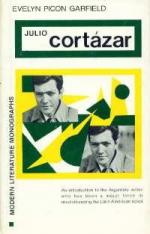|
This section contains 5,780 words (approx. 20 pages at 300 words per page) |

|
SOURCE: Sanjinés, José. “‘Blow-Up’: A House with Many Stories.” Point of Contact 4, no. 1 (fall-winter 1994): 46-55.
In the following essay, Sanjinés analyzes the narrative framework of “Blow-Up,” asserting that the story “is constructed on the principle of Chinese boxes.”
I. All the Frames of the Frame
One of Cortázar's best-known short stories, “Blow-Up,” is constructed on the principle of Chinese boxes. The text consists of a series of stories interpolated one within the other; each new story in the syntagmatic disposition signals a new hierarchical level and opens a new internal frame. Although the agile narrative transitions veil many of these borders and generate in the reader a sometimes disorienting illusion of continuity, the main internal frames of the story can be described with relative precision.
The first frame occupies more or less the first two pages. The narrator, who is also a writer, deliberates about...
|
This section contains 5,780 words (approx. 20 pages at 300 words per page) |

|


